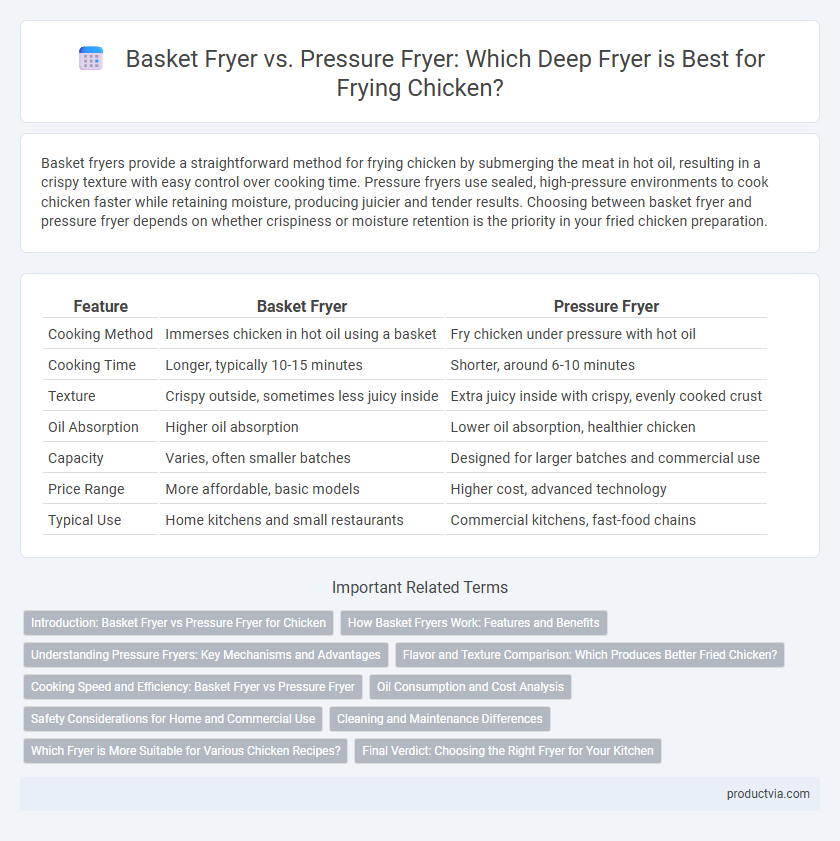Basket fryers provide a straightforward method for frying chicken by submerging the meat in hot oil, resulting in a crispy texture with easy control over cooking time. Pressure fryers use sealed, high-pressure environments to cook chicken faster while retaining moisture, producing juicier and tender results. Choosing between basket fryer and pressure fryer depends on whether crispiness or moisture retention is the priority in your fried chicken preparation.
Table of Comparison
| Feature | Basket Fryer | Pressure Fryer |
|---|---|---|
| Cooking Method | Immerses chicken in hot oil using a basket | Fry chicken under pressure with hot oil |
| Cooking Time | Longer, typically 10-15 minutes | Shorter, around 6-10 minutes |
| Texture | Crispy outside, sometimes less juicy inside | Extra juicy inside with crispy, evenly cooked crust |
| Oil Absorption | Higher oil absorption | Lower oil absorption, healthier chicken |
| Capacity | Varies, often smaller batches | Designed for larger batches and commercial use |
| Price Range | More affordable, basic models | Higher cost, advanced technology |
| Typical Use | Home kitchens and small restaurants | Commercial kitchens, fast-food chains |
Introduction: Basket Fryer vs Pressure Fryer for Chicken
Basket fryers use open hot oil to cook chicken, providing a crispy, golden exterior with a classic fried texture. Pressure fryers combine high heat and pressurized steam to cook chicken faster, locking in moisture for juicier, tender results. The choice between these fryers impacts cooking time, texture, and moisture retention in fried chicken.
How Basket Fryers Work: Features and Benefits
Basket fryers operate by submerging a wire mesh basket filled with chicken into hot oil, allowing for quick and even cooking through direct contact with the oil, which results in a crispy outer layer. Features such as adjustable temperature controls and timer settings enable precise cooking, minimizing oil absorption and promoting consistent texture. Benefits include ease of use, faster batch turnover compared to traditional pan frying, and simple maintenance, making basket fryers ideal for small to medium volume fried chicken production.
Understanding Pressure Fryers: Key Mechanisms and Advantages
Pressure fryers cook chicken by combining high temperature with pressurized steam, sealing in moisture and enhancing flavor compared to traditional basket fryers. This mechanism reduces cooking time while producing a juicier, crispier crust, making it ideal for commercial use and high-quality fried chicken. Pressure frying also minimizes oil absorption, resulting in a healthier final product with consistent texture and taste.
Flavor and Texture Comparison: Which Produces Better Fried Chicken?
Basket fryers produce fried chicken with a traditional crispy texture and lighter flavor due to direct oil contact and open frying. Pressure fryers trap steam, resulting in juicier meat and a more intense flavor with a tender, less crispy crust. For richer flavor and moist texture, pressure fryers are preferred, while basket fryers excel in creating crispier, more classic fried chicken.
Cooking Speed and Efficiency: Basket Fryer vs Pressure Fryer
Basket fryers typically cook chicken by immersing it in hot oil at atmospheric pressure, resulting in longer cooking times and moderate energy consumption. Pressure fryers use high-pressure environments to raise the boiling point of oil, significantly reducing cooking time while enhancing moisture retention and efficiency. The increased cooking speed of pressure fryers leads to higher throughput and energy savings in commercial frying operations.
Oil Consumption and Cost Analysis
Basket fryers typically use more oil as they require full submersion of chicken pieces, leading to higher oil consumption and increased operational costs. Pressure fryers use less oil by cooking chicken under pressure, reducing oil absorption and lowering overall oil usage and expenses. Cost analysis indicates that pressure fryers, despite higher upfront investment, offer long-term savings through reduced oil consumption and improved cooking efficiency.
Safety Considerations for Home and Commercial Use
Basket fryers offer straightforward operation and minimal mechanical components, reducing potential safety hazards such as pressure-related explosions, making them suitable for home kitchens. Pressure fryers, commonly used in commercial settings, incorporate sealed cooking environments that rapidly cook chicken under high pressure but require rigorous maintenance and specialized training to prevent risks like hot oil blowouts and equipment malfunction. Proper safety measures, including regularly checking seals and pressure valves, are essential for commercial pressure fryers, whereas basket fryers benefit from easier monitoring and lower risk in both home and small-scale commercial use.
Cleaning and Maintenance Differences
Basket fryers feature open baskets that are easier to remove and clean, allowing quicker access to oil and fry chambers for routine maintenance. Pressure fryers seal tightly, requiring more disassembly and careful cleaning of gaskets and pressure valves to maintain safety and performance. Regular grease removal and thorough cleaning are crucial for both types to ensure optimal frying quality and extend equipment lifespan.
Which Fryer is More Suitable for Various Chicken Recipes?
Basket fryers offer versatile frying suitable for crispy, evenly cooked fried chicken with a traditional texture, ideal for recipes requiring a lighter, crunchy coating. Pressure fryers lock in moisture and infuse flavors, producing juicier, tender chicken perfect for recipes needing a moist interior and a thicker, crisp crust. Choosing between a basket fryer and a pressure fryer depends on the desired chicken texture and recipe specifics, with basket fryers excelling in classic fried chicken and pressure fryers favored for moist, flavorful variations.
Final Verdict: Choosing the Right Fryer for Your Kitchen
Basket fryers offer ease of use and affordability, making them ideal for small kitchens and casual cooking. Pressure fryers produce juicier, faster-cooked chicken with a crispier texture, preferred in commercial settings for consistent quality. The final choice depends on volume requirements, flavor preferences, and budget constraints to optimize kitchen efficiency.
Basket fryer vs Pressure fryer for frying chicken Infographic

 productvia.com
productvia.com